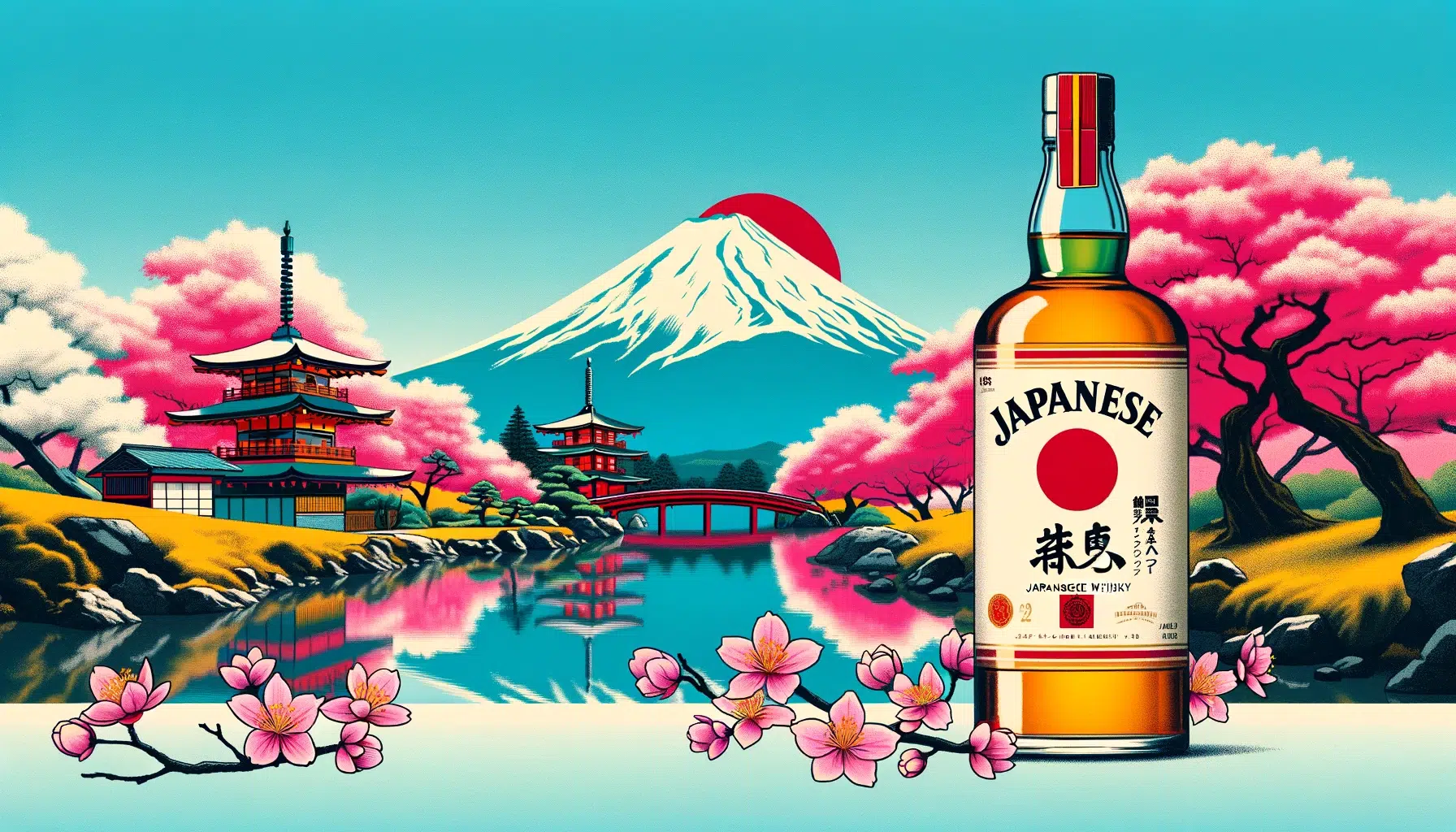Whiskies from all corners of the world have their own flair, but Japanese whisky? It’s in a league of its own. Blending centuries-old distilling skills with a knack for breaking new ground, the diversity and originality of Japanese whisky are a perfect reflection of vibrant Japanese Culture.
Digging a bit into history, Japanese whisky owes a lot to its Scottish counterpart. Back in the early 20th century, Japanese distillers turned to the Scottish Highlands for inspiration, blending the art of Scotch whisky-making with Japan’s meticulous attention to detail. This cross-cultural handshake laid the foundation for a whisky that respects tradition while embracing a distinctly Japanese character.
Let’s dive deeper into what makes this whisky tick, exploring the craftsmanship and traditions that give it its signature appeal.
Types of Japanese Whisky
Japanese whisky is one of many types of whiskey. Japanese whisky is known for unique characteristics and production techniques. Single Malt Whisky, distilled from malted barley at a single distillery, offers a pure expression of the distiller’s art. Blended Japanese Whisky combines both malt and grain whiskies from various distilleries, creating a harmonious blend that is both complex and balanced.
Grain Whisky, often made from grains other than barley, introduces a lighter, frequently sweeter profile to the palate. Pure Malt Whisky, also known as blended malt, merges single malts from different distilleries. This type emphasizes the art of blending without incorporating grain whisky, showcasing the distiller’s skill in creating balance and harmony.
Single Cask Whisky is a rare expression from one barrel, offering a unique, unrepeatable experience with each bottle. Cask Strength Whisky is bottled directly from the cask without dilution, capturing the full flavor and potency of the whisky, offering an intense tasting experience. Lastly, Peated Whisky incorporates peat in the malting process, imbuing the whisky with distinctive smoky notes that are both profound and nuanced.
Each type of Japanese whisky opens a door to the diverse and intricate world of this revered spirit, promising a journey of discovery for both enthusiasts and novices.
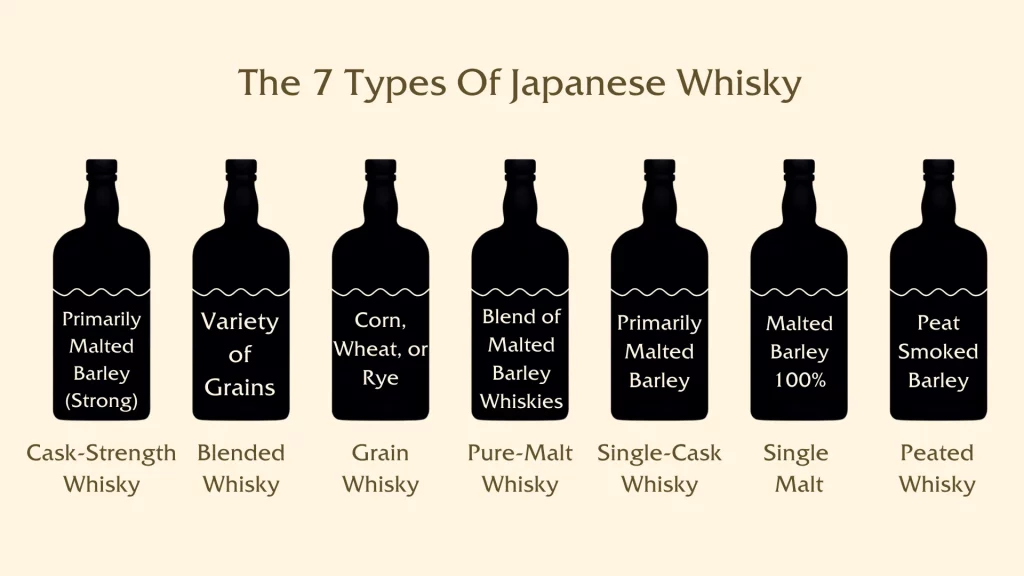
Single Malt Whisky
Single Malt Whisky stands as a testament to the distillery’s unique environment and production methods, crafted exclusively from malted barley. This type offers a deep dive into the essence of its origin, presenting a flavor profile rich in complexity and character.
Blended Japanese Whisky
Blended Japanese Whisky is a symphony of malt and grain whiskies, meticulously selected from various distilleries. The artistry of blending achieves a seamless balance, producing a whisky that is both complex in flavor and smooth in finish, catering to a diverse audience of whisky lovers.
Grain Whisky
Crafted primarily from non-barley grains, Grain Whisky introduces a lighter, often sweeter dimension to the whisky spectrum. Its versatility makes it a cornerstone in blended whiskies, contributing to their approachability and smoothness.
Pure Malt Whisky
Pure Malt Whisky, or blended malt, marries single malts from multiple distilleries, excluding grain whisky. This blend highlights the craft of blending, weaving together varied malt profiles into a complex, multifaceted whisky that celebrates the diversity of Japanese single malts.
Single Cask Whisky
Single Cask Whisky is the product of a singular barrel, making each bottle a unique expression of time and place. These limited releases capture the distinctive influence of the cask, offering an intimate glimpse into the nuances of whisky aging. Single cask whisky is a highly prized collectors item, if you want to learn more about what makes a whiskey collection worthy, check out our article on whiskey collecting.
Cask Strength Whisky
Cask Strength Whisky delivers the whisky in its most potent form, bottled directly from the cask without dilution. This unadulterated presentation preserves the full spectrum of flavors and the robust intensity of the whisky, providing an immersive tasting experience.
Peated Whisky
Characterized by its bold, smoky essence, Peated Whisky owes its distinctive profile to the use of peat-smoked barley. This type caters to those who savor the depth and intensity of smoky flavors, adding a rich, complex layer to the Japanese whisky landscape.
Distinct Characteristics of Japanese Whisky
Japanese whisky distinguishes itself through a unique blend of attributes that resonate deeply with Japan’s cultural ethos. At its core, Japanese whisky embodies balance and harmony, reflecting a meticulous consideration for equilibrium in flavor and character. Japanese whisky is the product of precision and attention to detail in the whiskey production process, a traits that is ingrained in Japanese craftsmanship.
Each step of the whisky-making process is carefully monitored to ensure the highest quality. Innovations in aging practices play a crucial role in defining the whisky’s profile. Japan’s diverse climate offers unique conditions that influence the aging process, imparting distinct flavors and adding complexity to the whisky.
Furthermore, the blending artistry of Japanese distillers is unmatched, combining various whiskies to achieve a perfect balance of flavors. This skillful blending results in whiskies that are not only complex but also exhibit a harmonious flavor profile, making Japanese whisky a revered choice among enthusiasts. These characteristics—balance, precision, innovative aging, and blending artistry—together forge the identity of Japanese whisky, distinguishing it as a premium spirit on the global stage.
Balance and Harmony
Balance and Harmony are the cornerstone of Japanese whisky, where every sip reflects a meticulous blend of flavors and aromas that coexist in perfect unity. This principle ensures that no single element overshadows another, creating a harmonious experience that is both refined and inviting.
- Example: Hibiki Harmony exemplifies this balance, offering a symphony of honey, orange, and a hint of Japanese incense, achieving a smooth and harmonious blend that appeals to a wide range of palates.
Precision and Attention to Detail
In the realm of Japanese whisky, Precision and Attention to Detail are paramount. Distillers pay close attention to every phase of the production process, from the careful selection of barley to the precise moment of distillation. This dedication to detail ensures the highest quality and consistency, distinguishing Japanese whisky on the global stage.
- Example: The Yamazaki Distillery meticulously selects its oak casks, with some being handmade from Mizunara oak, a rare and indigenous tree to Japan, showcasing their commitment to precision in crafting a unique flavor profile.
Innovative Aging Practices
Innovative Aging Practices set Japanese whisky apart, leveraging the country’s diverse climates to influence the maturation process. From aging in coastal warehouses to mountainous retreats, these unique conditions imbue the whisky with a rich array of flavors, enhancing its complexity and character.
If you want to learn more about aging and it’s place in the production process, check out our article on whiskey production.
- Example: Yoichi Distillery, located in Hokkaido, benefits from its cold and humid climate, which contributes to the bold and strong character of its whisky, with a distinct peaty note and a rich, full body.
Blending Artistry
The Blending Artistry of Japanese whisky is a craft in itself, where master blenders skillfully combine various whiskies to achieve a seamless and complex blend. This expertise allows for the creation of whiskies that are not only balanced but also exhibit a depth of flavor that is both unique and captivating.
- Example: Nikka From the Barrel is a powerful blend of malt and grain whiskies from Nikka’s Yoichi and Miyagikyo distilleries, aged in multiple types of barrels. The result is a rich, full, and complex whisky that showcases the masterful blending and craftsmanship of Nikka’s blenders.
The Rich Flavor Spectrum of Japanese Whisky
Japanese whisky is renowned for its rich flavor spectrum, a vivid palette that ranges from fruity and floral to peaty and smoky, complemented by sweet and woody accents. This diversity stems from the meticulous craftsmanship and innovative practices of Japanese distillers, who skillfully balance tradition with experimentation. The signature flavor notes of Japanese whisky make it not only a versatile spirit for pairing with a wide array of dishes but also ensure there is a variant to match every preference.
Whether one seeks the gentle caress of fruity and floral notes or the bold embrace of peaty and smoky undertones, Japanese whisky offers a complex profile that captivates and delights.
If you want to fully appreciate every drop of Japanese whisky, it’s recommended that you familiarise yourself with the whiskey tasting process.
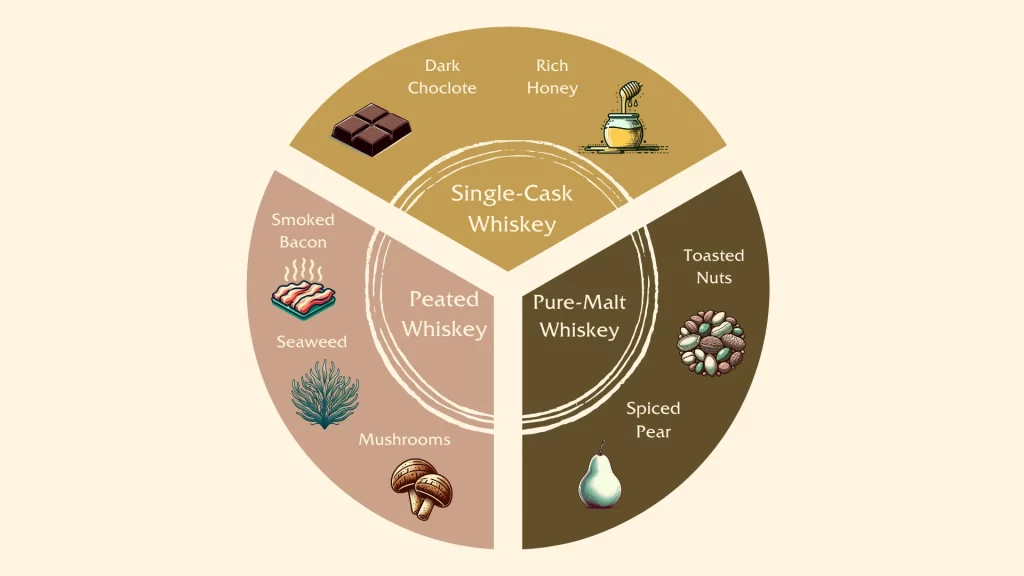
Signature Flavor Notes in Japanese Whisky
Japanese whisky captivates with its signature flavor notes, a testament to the distillers’ mastery over their craft. From the serene to the intense, these flavors offer a glimpse into the rich tapestry of Japan’s natural and cultural heritage.
Fruity and Floral Notes
Whiskies imbued with fruity and floral notes evoke the serene beauty of Japan’s blooming landscapes. Delicate whispers of apple, pear, and cherry mingle with the soft fragrances of blossoms, crafting a profile that is both refreshing and subtly complex.
- Example: The Hakushu Distiller’s Reserve is a prime example of this category, offering a fresh, verdant profile with hints of mint, melon, and cucumber, alongside a subtle smokiness.
Peaty and Smoky Undertones
For a journey into the heart of Japan’s rugged terrain, whiskies featuring peaty and smoky undertones deliver a bold and earthy flavor. The smokiness, reminiscent of ancient forests and peat bogs, creates a profound depth that appeals to those who seek a whisky with character and intensity.
- Example: Yoichi Single Malt, with its coastal peatiness, offers a robust smokiness complemented by rich fruit and nutty notes, embodying the essence of its northern Hokkaido environment.
Sweet and Woody Accents
The sweet and woody accents in Japanese whisky highlight the art of aging. Vanilla, caramel, and honey notes, enriched by the oak’s warmth, weave through the whisky, adding layers of richness and a smooth finish that lingers on the palate.
- Example: Yamazaki 18 Year Old is renowned for its deep, multi-layered taste, featuring dark chocolate, dried fruit, and a rich sherry cask influence, making it a luxurious example of sweet and woody complexity.
Pairing Japanese Whisky with Food
Pairing Japanese whisky with food is an art that enhances the dining experience, creating a symphony of flavors that complement and elevate each other. The diverse flavor spectrum of Japanese whisky, ranging from fruity and floral to peaty and smoky, offers endless possibilities for culinary pairings. Whether it’s the subtle enhancement of savory dishes or the rich complement to sweet desserts, Japanese whisky can adapt to highlight the best aspects of various cuisines.
This harmonious interplay between whisky and food not only showcases the depth and versatility of Japanese whisky but also transforms a meal into an immersive sensory journey.
Complementing Flavors in Savory Dishes
Japanese whisky seamlessly complements savory dishes, enhancing their flavors through its diverse profile. Peaty and smoky undertones in the whisky can intensify the richness of grilled meats, adding a layer of depth, while whiskies with fruity and floral notes are perfect for accentuating the delicate flavors of seafood or fresh vegetable dishes. The art lies in pairing the whisky’s intensity with the dish’s character, achieving a balance that elevates the dining experience.
Complementing Flavors in Sweet Dishes
In the realm of sweet dishes, Japanese whisky acts as a delightful counterpart. Whiskies with sweet and woody accents naturally complement the decadence of chocolate desserts, enriching their taste. Conversely, lighter, fruity whiskies can enhance the freshness of fruit tarts or sorbets, adding a vibrant note.
This interplay between the whisky and dessert creates a symphony of flavors, unveiling new dimensions of taste with each bite.
| Whisky Type | Flavor Profile | Food Pairing | Dish Example |
|---|---|---|---|
| Peated Whisky | Smoky, Earthy | Grilled Meats | BBQ Pork Ribs |
| Single Malt | Fruity, Floral | Seafood | Grilled Salmon |
| Blended Whisky | Balanced, Smooth | Savory Dishes | Beef Teriyaki |
| Grain Whisky | Sweet, Light | Light Appetizers | Cheese Platter |
| Cask Strength | Intense, Robust | Spicy Foods | Spicy Chicken Wings |
| Pure Malt | Complex, Woody | Roasted Vegetables | Roasted Root Vegetables |
| Single Cask | Unique, Varied | Special Occasions | Gourmet Tasting Menus |
Grilled Meats and Peated Whisky: The intense smoky flavors of peated whisky, such as those from Yoichi, perfectly complement the charred exterior of grilled meats, enhancing the umami and smoky taste. Seafood and Single Malt: A fruity and floral single malt, like Yamazaki, pairs wonderfully with the delicate flavors of grilled salmon, highlighting the dish’s natural sweetness. Savory Dishes and Blended Whisky: The smooth and balanced profile of a blended whisky, such as Hibiki, is ideal for enhancing the flavors of savory dishes like beef teriyaki without overpowering them.
Light Appetizers and Grain Whisky: The sweet and light character of a grain whisky, such as Chita, pairs well with a cheese platter, complementing the creaminess and variety of flavors. Spicy Foods and Cask Strength Whisky: The robust and intense flavors of a cask strength whisky, like Yamazaki Sherry Cask, can stand up to spicy dishes, balancing the heat with its depth of flavor. Roasted Vegetables and Pure Malt: The complex and woody notes of a pure malt whisky, such as Nikka Taketsuru, enhance the earthiness of roasted root vegetables, adding an extra layer of flavor.
Special Occasions and Single Cask: For a unique dining experience, a single cask whisky, with its unique and varied profile, pairs well with gourmet tasting menus, offering a different flavor with each course.
Which Japanese Whisky Should You Try First?
Choosing your first Japanese whisky can be an exciting journey into a world of exquisite flavors. Whether your preference leans towards gentle, smooth flavors, ideal for those new to the whisky scene, or you’re drawn to bold, spicy notes, perfect for the adventurous palate, there’s a Japanese whisky waiting to be discovered. For enthusiasts of sweet, rich profiles, options abound that showcase the depth and complexity Japanese whisky is renowned for.
Each category provides a unique introduction to the diverse spectrum of Japanese whisky, inviting you to explore and find your personal favorite. No matter where your tastes lie, there’s a Japanese whisky that offers the perfect first sip.
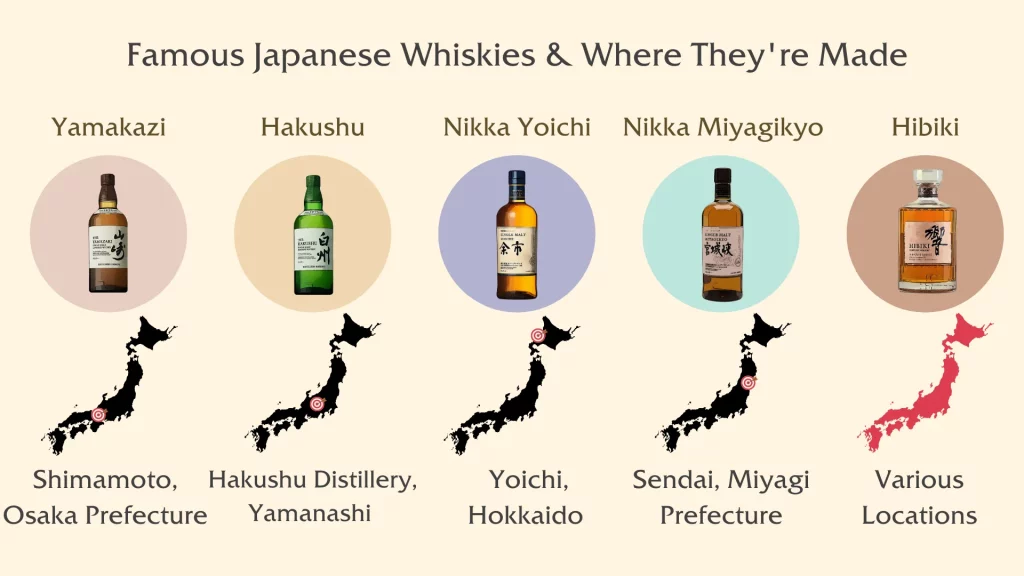
For Those Seeking Gentle, Smooth Flavors
Individuals inclined towards a softer touch should explore Japanese whiskies known for their gentle, smooth flavors. With a harmonious blend of fruity and floral notes, these whiskies provide an accessible entry point into the world of Japanese whisky. Perfect for novices or those who appreciate subtlety, they offer a refined and inviting tasting experience.
For Enthusiasts of Bold, Spicy Notes
Adventurous palates will be drawn to Japanese whiskies that boast bold, spicy notes. Characterized by their depth, with layers of peat and smoke, these whiskies cater to those seeking intensity and complexity. The spicy elements are skillfully balanced with the whisky’s rich character, making each sip a discovery of bold flavors.
For Lovers of Sweet, Rich Profiles
Those with a preference for decadence will find delight in Japanese whiskies with sweet, rich profiles. Emphasizing woody and sweet accents such as vanilla, caramel, and honey, these whiskies offer a sumptuous tasting experience. Ideal for moments of indulgence, they showcase the exquisite art of aging and blending practiced by Japanese distillers.
This detailed table provides a clear starting point for those new to Japanese whisky, offering recommendations based on flavor preferences and highlighting the unique qualities of each suggested bottle. Whether you’re drawn to the gentle whispers of Hakushu, the bold spirit of Yoichi, or the rich complexity of Yamazaki, there’s a world of flavors waiting to be explored.
Regulation Requirements Of Japanese Whisky
The integrity and authenticity of Japanese whisky are safeguarded by regulation requirements that define its production and aging process. These regulations specify that for a spirit to be labeled as Japanese whisky, it must be distilled in Japan, aged in wooden casks within the country for a minimum period, and meet rigorous production standards. These criteria ensure that only whiskies that truly represent the tradition and craftsmanship of Japanese distilling can bear the name.
Key Regulation Criteria for Japanese Whisky:
- Distillation Location: Must be distilled in Japan.
- Aging Requirements: Must be aged in wooden casks in Japan for a minimum of three years.
- ABV Requirements: Must be bottled at a minimum of 40% Alcohol By Volume (ABV).
- Ingredients: Must be made from malted grains, with water being the only permitted additive.
Comparison with Other Countries:
| Country | Distillation Location | Aging Requirements | ABV Requirements | Ingredients |
|---|---|---|---|---|
| Japan | Must be in Japan | Minimum 3 years | Minimum 40% ABV | Malted grains, water |
| Scotland (Scotch) | Must be in Scotland | Minimum 3 years | Minimum 40% ABV | Malted barley, water, yeast |
| USA (Bourbon) | Must be in the USA | No minimum, but new charred oak barrels | Minimum 40% ABV | Minimum 51% corn, water, yeast |
| Ireland (Irish Whiskey) | Must be in Ireland | Minimum 3 years | Minimum 40% ABV | Malted barley, may include other cereals |
Significance of Japanese Whisky Regulations:
The regulations surrounding Japanese whisky are designed to ensure the quality and authenticity of the spirit, reflecting the dedication to craftsmanship and tradition that defines Japanese distilling. Unlike American bourbon, which has a strict corn requirement, or Scotch, which must use malted barley, Japanese whisky regulations focus more on the process and location of production, allowing for a wide range of flavor profiles within the category. This flexibility, combined with strict aging and production standards, has led to Japanese whisky being highly regarded worldwide for its quality and complexity.
History of Japanese Whisky
The history of Japanese whisky is a compelling narrative that traces back to its origins and early development in the early 20th century. It was during this time that Japan began its venture into whisky production, drawing inspiration from Scottish distilling techniques. The pioneers of Japanese whisky were driven by a vision to meld the meticulousness of Scotch with the refined craftsmanship inherent to Japan.
This era of expansion and innovation witnessed the birth of Japan’s first distilleries, setting the stage for the distinctive style of Japanese whisky. As the industry evolved, Japanese whisky garnered global recognition, with several brands winning international awards for their exceptional quality and flavor. Today, the modern era of Japanese whisky is marked by a harmonious blend of tradition and innovation.
Distillers continue to explore new frontiers of taste and craftsmanship, solidifying Japanese whisky’s esteemed position in the global spirits landscape.
Origins and Early Development
The origins and early development of Japanese whisky can be traced back to two pivotal figures: Masataka Taketsuru and Shinjiro Torii. Taketsuru, known as the “Father of Japanese Whisky,” studied the art of distilling in Scotland and brought back his knowledge to Japan. In 1923, he joined forces with Torii, the founder of Kotobukiya (later Suntory), to establish Japan’s first whisky distillery, Yamazaki, near Kyoto.
This foundational period set the stage for the distinctive and celebrated tradition of Japanese whisky.
Expansion and Innovation
The Japanese whisky industry swiftly moved into a phase of expansion and innovation with the establishment of Nikka Whisky by Masataka Taketsuru in 1934, following his departure from Suntory. Nikka’s Yoichi distillery in Hokkaido was designed to replicate the Scottish whisky-making environment, emphasizing peat smoking and coal-fired stills. This era was characterized by groundbreaking advancements in distillation, aging, and blending processes, which contributed to the unique flavor profiles and identity of Japanese whisky.
These innovations underscored Japan’s commitment to creating a whisky that stood apart in the global spirits arena.
Global Recognition and Modern Era
Achieving global recognition has been a hallmark of the modern era of Japanese whisky. In the early 2000s, whiskies from Suntory and Nikka began to win prestigious international awards, catapulting Japanese whisky into the global spotlight. Notably, the Yamazaki Single Malt Sherry Cask 2013 was named the world’s best whisky in 2014 by Jim Murray’s Whisky Bible, a significant accolade that highlighted the excellence of Japanese whisky on the world stage.
Today, Japanese whisky is synonymous with exceptional quality, continuous innovation, and unmatched craftsmanship. Distillers remain dedicated to pushing the boundaries of whisky-making, ensuring that Japanese whisky’s legacy and prestige endure on the world stage. The industry’s commitment to quality and innovation continues to inspire new distilleries across Japan, contributing to the rich tapestry of Japanese whisky and its growing popularity among connoisseurs and casual drinkers alike.
Comparing Japanese Whisky To Other Whiskeys
Japanese whisky carves out a unique niche in the global whiskey landscape, marked by its distinct characteristics and production ethos. Compared to Irish Whiskey, renowned for its smoothness and triple distillation, Japanese whisky places a premium on balance and subtlety, with a keen emphasis on the art of blending. Against the backdrop of American Whiskey, which encompasses the robust flavors of bourbon and rye, Japanese whisky typically presents a more delicate and nuanced profile.
In contrast to Canadian Whisky, known for its versatility and often lighter character, Japanese whisky demonstrates a depth of flavor that is meticulously cultivated through its aging processes. Lastly, when juxtaposed with Scotch Whisky, its closest relative in terms of heritage, Japanese whisky distinguishes itself through precision and innovation, offering a unique interpretation of traditional distilling techniques. Each comparison underscores the singular position of Japanese whisky in the spirits world, celebrated for its dedication to quality, innovation, and a distinctive flavor profile that melds Eastern and Western distilling traditions.
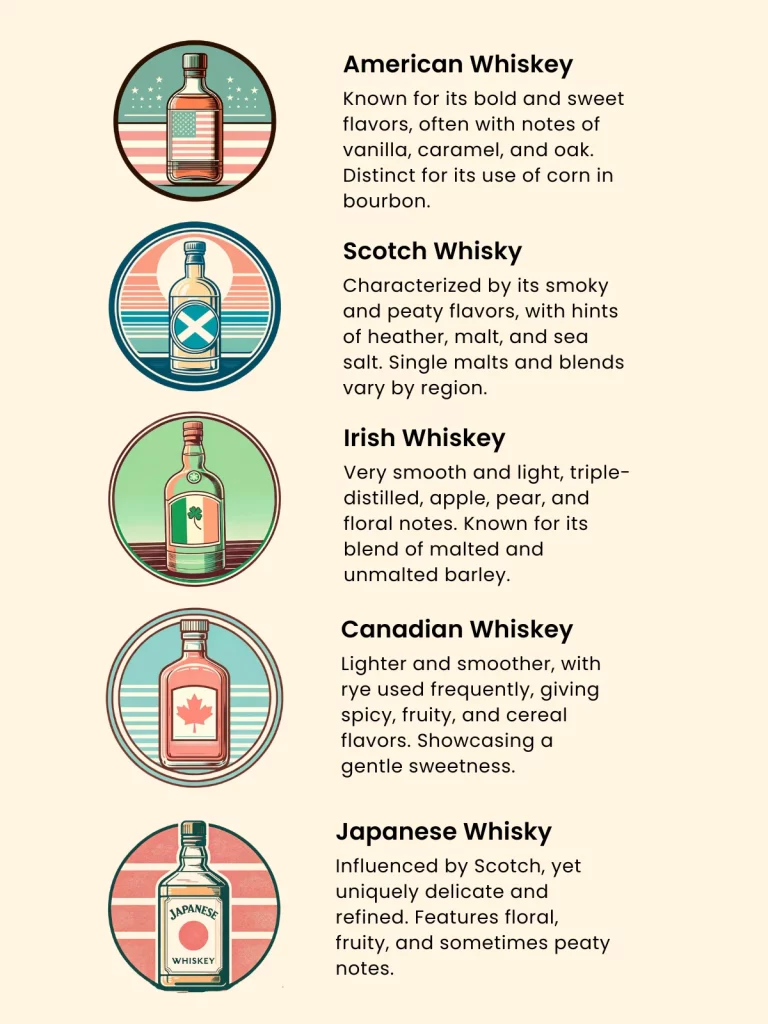
Japanese Whisky vs Irish Whiskey
Japanese Whisky stands apart from Irish Whiskey through its approach to flavor harmony and blending precision. While both emphasize smoothness, Japanese whisky achieves this through a meticulous balance of flavors, whereas Irish whiskey is known for its triple-distillation process, making it exceptionally smooth and light.
Japanese Whisky vs American Whiskey
Contrasting Japanese Whisky with American Whiskey reveals differences in flavor boldness. American whiskey, especially bourbon, is characterized by its sweet, full-bodied profile, thanks to corn dominance and aging in new oak barrels. Japanese whisky, however, leans towards subtlety and refinement, prioritizing balance and a nuanced flavor palette.
Japanese Whisky vs Canadian Whisky
Japanese Whisky and Canadian Whisky both prize versatility, yet Japanese whisky sets itself apart with its complex aging process and a keen focus on flavor equilibrium. Canadian whisky is generally lighter and smooth, often with a noticeable rye spice, showcasing a different aspect of whiskey craftsmanship.
Japanese Whisky vs Scotch Whisky
Japanese Whisky and Scotch Whisky share a common inspiration but follow distinct trajectories. Inspired by Scotch, Japanese whisky mirrors its complexity and richness but adds a layer of innovation and precision unique to Japanese distillation. Scotch whisky, with its diverse regional expressions from peaty Islay malts to gentle Speyside blends, offers a wide flavor spectrum rooted in centuries of Scottish tradition.

